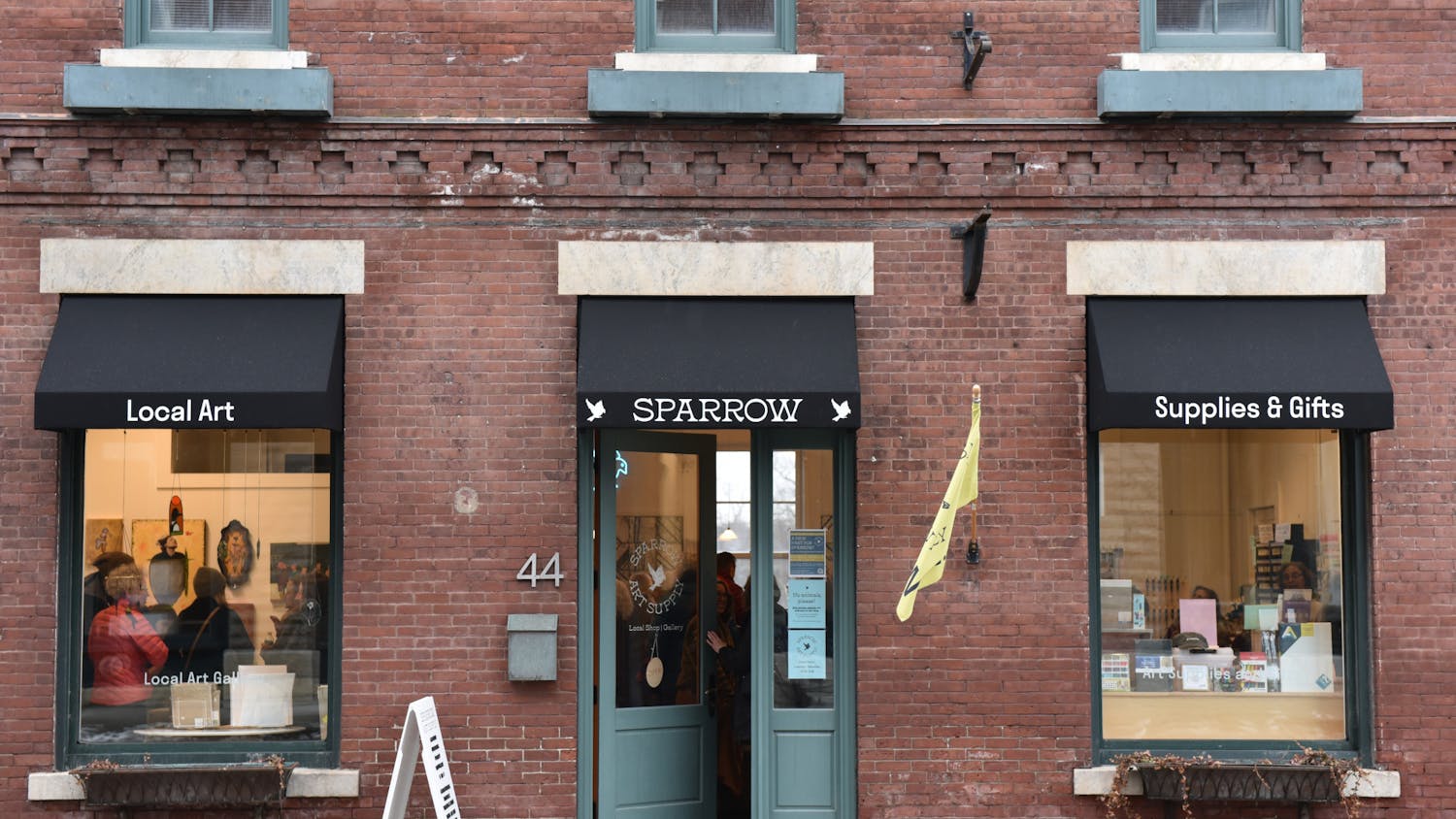I had noticed a couple of times a locked door in Bihall with pictures of octopuses and a sign “octopi wallstreet”, so when my friend Jacob Dixon ’16.5 mentioned he was going to feed the baby octopuses my curiosity was naturally raised and I offered to tag along. When I stepped inside the cephalapod room with its loudly humming pumps and filters and its strong stench of marine biology, I felt removed from Middlebury. Packed inside the room, originally a small janitor’s supply closet, were two 300-galllon tanks containing the octopuses (octopodes is also an acceptable plural, but not octopi). In the first tank one of the three adult California two-spot octopuses floated in sight. Its tentacles stretched nearly a foot and a half, and on its side was its characteristic bright blue dot, one of the two false eyes that give the octopuses their name. Jacob went about feeding small shrimp to the 48 thumb-nail sized babies floating in Tupperware containers on the top of the two tanks.
The College has intermittently kept octopuses for neurological and psychological research since 2008, when two students along with Biology Professor Tom Root opened the lab to study invertebrate intelligence. Researchers have found that octopuses have remarkably complex minds and have evolved emotions, individual personalities and intelligence. Students at the College have sought to build off these discoveries and delve into the workings of the octopus brain and the nature of the mind. In past experiments, students have tested the memories of octopuses by placing them in mazes. Jamie Hillas ’15 will begin a project this spring also investigating the learning capabilities of octopuses. But before Hillas is able to do research, the octopus babies will have to survive and mature.
Alexandra Spencer-Wong ’16 and Amity Calvin ’16 head a crew of volunteers including Jacob Dixon ’16.5, Lisa Wooldridge ’16, Michelle Irei ’15, Tiff Ting ’14, Max Anderson ’14, and Alix Bickson ’14 in charge of the daunting task of looking after and feeding the baby octopuses. Last year another team of caretakers ran into unfortunate problems while taking care of a different group of baby octopuses.
“They had them during the spring and they survived for 6 weeks,” Calvin said, “but they went off on a break and when they came back they found out there was a high spike in nitrate levels, and they all died.”
Dixon, a published aquarium enthusiast, also explained how maintaining good water quality and monitoring the levels of dangerous chemical byproducts is the most essential part of keeping an aquarium.
“Octopuses and invertebrates in general are very sensitive to nitrate,” he said, “and I think that was the reason for their deaths. For example in my aquarium at home I tried to keep the nitrate levels between zero and five parts per million (ppm). In here they spiked about forty.”
He described a number of ways he kept nitrate levels in check in his previous aquariums and how they are currently trying to do so with the octopus tanks.
“You can introduce live rock with resident nitrifying bacteria that convert nitrate into a more disposable form, or you can introduce macroalgae and they consume nitrates as they grow,” Dixon said. “One of the best ways is to cycle clean pure water through and remove the water with nitrates.”
The octopus eggs were laid in December, and they hatched during February break. Spencer-Wong recalled the excitement of that day.
“We were about to leave — it was just a routine feeding,” he said, “then I looked down and I said ‘Amity, what’s that there’. All of a sudden there were babies everywhere. They would hatch in waves of 15. We had literally made the Tupperware container the day before. I put up this really desperate Facebook status calling anyone on campus to come to the room and help, thankfully a couple of friends showed up. There was a frenzy to try and catch them and put them in the right place and make sure they didn’t slip through the cracks of the aquarium. That was a challenge.”
Since then they have been busy feeding and looking after the octopuses.
“We’ve been feeding them twice a day and we do one head count a day,” Calvin said. “It’s been difficult finding out how much we need to feed them to keep them from eating each other.”
Another difficulty is keeping them from escaping.
“They are the greatest escape artists that you have ever seen,” Wooldridge said. “I’ve opened the tank to catch one and I’ve seen one trying to climb out of the tank and I have to push them back down.” Reportedly 6-foot long octopuses can squeeze through a hole the size of an orange.
“We didn’t anticipate this continuing in the spring,” Spencer-Wong said. “We thought we would come by and maybe feed them once a week. But now we’re pretty much in charge of feeding the babies which is intense but it’s been a fun experience and we’ve learned a lot.”
After watching the creatures for a few minutes jet around and wrap their snarling tentacles around prey I could easily see how spending time with them was enticing.
“One of the best things about working with them is that you can see a personality,” Spencer-Wong said. “You can see for instance ‘oh, Reggies is grumpy today’ or when I wear a very intensely patterned sweater the octopus would put up these angry horns and run away so I stopped wearing that sweater around them.”
“Their color changing capabilities are just incredible,” Calvin added. “They can blend in so perfectly, and they change color a lot of the time. When you feed them, sometimes their blue spots will pulse very quickly. When they are relaxed they turn this calm, pale, white shade. “
The group hopes that at least 10 of the baby octopuses will survive into the spring. Currently they have 7 student volunteers.
“You can never have too many volunteers,” Calvin said. “If you know anyone whose interested send them over. We’re gonna work with the octopuses until there are no more left.”
Science Spotlight: Octopus Biology
Comments



